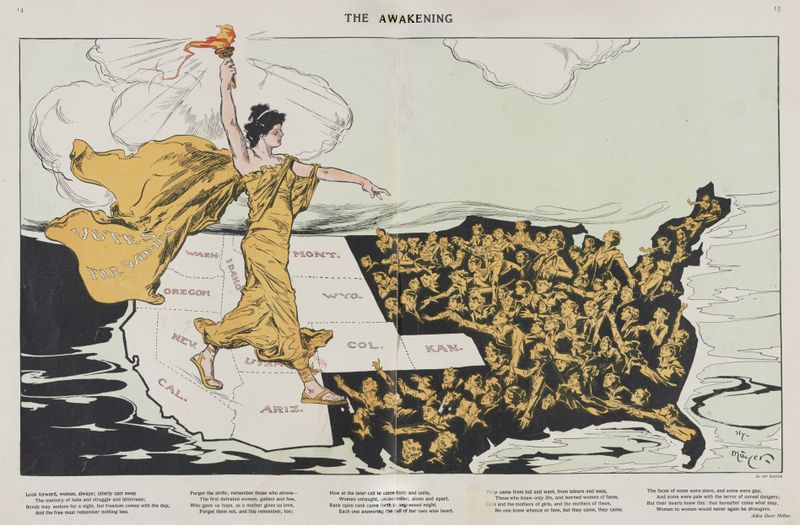It’s perhaps the most basic right of all: The right to be heard.
For thousands of years, women weren’t. No one in power listened to them. They had little control over their bodies, their finances, their lives.
But a few women realized if they won one right — the right to vote — all else might follow.
“Suffrage: Women’s Long Battle for the Vote” by Ellen Carol Dubois chronicles that struggle, which peaked 100 years ago with the ratification of the 19th Amendment. The book notes that the larger fight, for full equality, goes on.
The women’s war was long and intense. It would grow to include picket lines, hunger strikes, and physical violence. But it began quietly in Seneca Falls, N.Y., on a hot summer Sunday in 1848, when Elizabeth Cady Stanton met friends for tea.

“Suffrage: Women’s Long Battle For The Vote” by Ellen Carol Dubois (Simon & Schuster)
“Cleanliness, order, the love of the beautiful and artistic, all faded away in the struggle to accomplish what was absolutely necessary from hour to hour,” she complained.
Talking to the other women, she unleashed “the torrent of my long-accumulating discontent with such vehemence and indignation that I stirred myself, as well as the rest of the party, to do and dare anything.” The friends decided to hold a two-day public meeting on “the social, civil, and religious conditions and rights of women.”

Elizabeth Cady Stanton organized the world’s first women’s rights convention in Seneca Falls, New York in 1848. She was the first President of National Women’s Suffrage Association, an office she held from 1869 to 1890. (ASSOCIATED PRESS)
The Founding Fathers had begun America’s war for independence by publishing a list of grievances. These women would do the same for their gender.
Titled “Declaration of Sentiments,” their broadside began with familiar but significantly altered language. “We hold these truths to be self-evident,” it read. “That all men and women are created equal.” And it ended with a groundbreaking resolution: “That it is the duty of the women of this country to secure to themselves their sacred right to the elective franchise.”
The fight for the vote had begun.
Many of the early suffragists came out of the abolitionist movement and supported black activists such as Frederick Douglass and Sojourner Truth. Yet, as the Civil War wound down, and progressives talked of extending voting rights to black men, some white suffragists were taken aback.

Abolitionists Frederick Douglass and Sojourner Truth met with President Abraham Lincoln in the White House. (AP/Getty)
Stanton was convinced she was superior to African-Americans and when challenged about this, she became haughty. She did not want black men or immigrants to have the vote before women and would huff about her heritage. She spoke about “the blood of Pilgrims” “daughters of the Revolution” and the power of her Saxon heritage.
Douglass, an old friend and ally, cautioned Stanton on insulting language. He also insisted the fight for black male suffrage must take precedence.
“With us, it is a matter of life and death,” he said. “When women, because they are women, are hunted down; when they are dragged from their homes and hung upon lampposts; when their children are not allowed to enter schools; then they shall have an urgency to obtain the ballot equal to our own.”
Of course, black women faced that same violence and discrimination. But when the Fifteenth Amendment was ratified in 1870, it guaranteed the vote only to men. Still, Stanton pushed forward, along with a growing wave of feminists.

Susan B. Anthony led the fight for women to have the right to vote. (AP)
Susan B. Anthony, who met Stanton in 1851, and became her lifelong friend, shared some of Stanton’s anti-immigrant sentiments, protesting that even “Bohemians, Swedes, Norwegians” had a right that she and other women did not. Imagine, she wrote Congressman Ben Butler, “begging them to vote to let you vote. You’d feel the insult quite as keenly as I.”
But if Anthony had some of Stanton’s prejudices, she also had her righteous perseverance. Tireless agitators, the two gave speeches, pressured legislators, formed alliances, and founded a long list of activist organizations. The movement grew.
Although both Anthony and Stanton were dead by then, others took up the fight. Yet as their resolve grew stronger, so did the opposition.
In 1914, the day before Woodrow Wilson’s first inauguration, suffragists held a parade in Washington to promote voting rights and call for the new president’s support. Crowds attacked the women, breaking their signs and pulling their clothes.

“The police stood by so passively that some thought they were intentionally enabling the rioters,” Dubois writes.
Three years later, activists tried an even more direct approach, picketing outside the White House. It was a brand-new political tactic, and locals and tourists looked on in wonder as suffragists waved silk banners asking “How Long Must Women Wait for Liberty?”
“Longer,” it seemed. Once America entered World War I, Wilson had even less time for the suffragists.
Once, a mob attacked the women, chasing them back to their headquarters. One man fired a gun through a second-story window.

Alice Paul, 1915 Contributor: Harris & Ewing (Library of Congress) (Library of Congress)
Fearlessly, the feminists kept returning. Ruthlessly, the authorities moved against them. Police arrested them on a variety of pretexts. Judges handed down stiff sentences. After joining the picketers, feminist Alice Paul was given seven months in jail. Once inside, she and another activist, trade unionist Rose Winslow, began a hunger strike.
It took more than a month for lawyers to win their release.
As 1918 dawned, though, Wilson was finally ready to come around. The war was ending, and he needed women’s support not only for his peace plan but post-war reforms. He told congressional Democrats to push through a suffrage amendment.
By a vote of 50-49, Tennessee finally pushed it over the finish line on Aug. 19, 1920.
Women had the vote. Now, what would they do with it?


